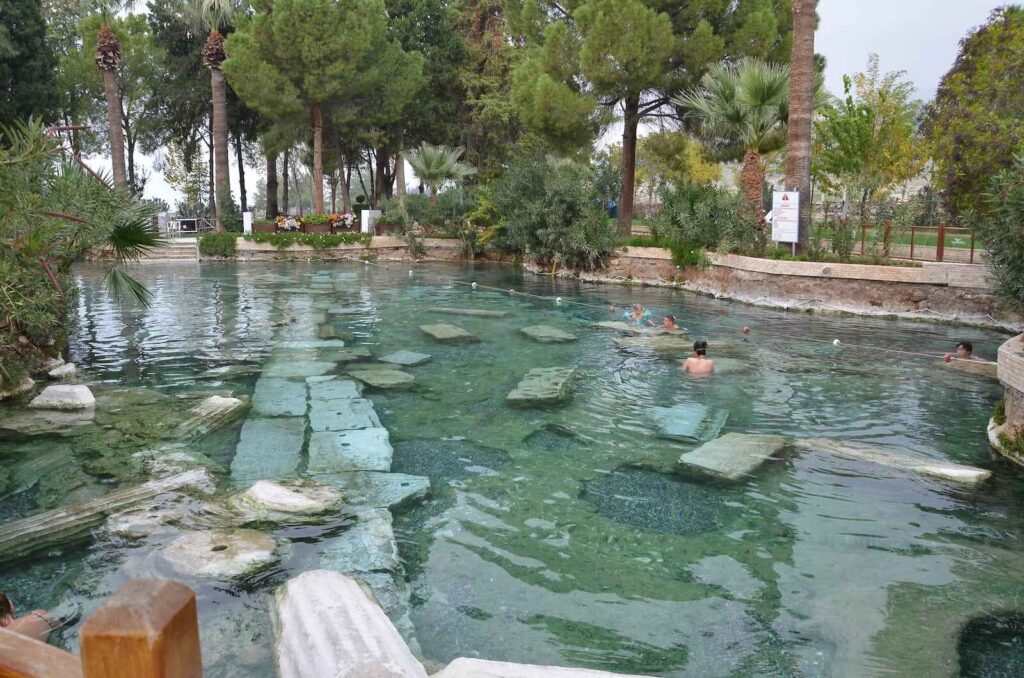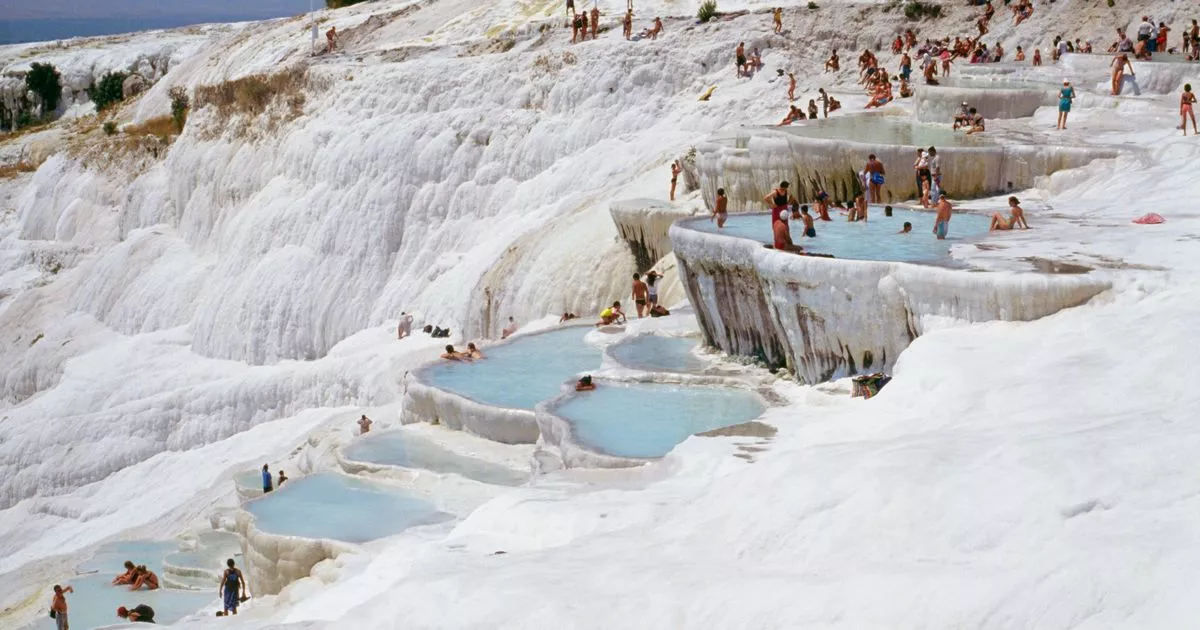Pamukkale Thermal Pools: Pamukkale, meaning “Cotton Castle” in Turkish, is a breathtaking natural wonder in Denizli Province, western Turkey. Famous for its white travertine terraces, this UNESCO World Heritage Site has captivated travelers for centuries. Here, mineral-rich hot springs flow down the hillside, forming cascading pools that shine like snow under the sun. In reality, the waters are warm, soothing, and wonderfully surreal.
Moreover, whether you’re a nature lover, history enthusiast, or a traveler seeking relaxation, Pamukkale offers a perfect mix of natural beauty and ancient heritage. As a result, it remains a bucket-list destination that combines healing waters with timeless charm.

How Pamukkale Was Formed: The Science Behind the Beauty
Pamukkale’s terraces glow white with travertine, a natural rock created by calcium-rich thermal spring water. As the hot water cools and evaporates, it leaves behind layers of calcium carbonate, forming steps and basins that look like soft, fluffy cotton.
Today, visitors can see 17 hot water springs in the area, with temperatures ranging from 35°C to 100°C (95°F to 212°F). Over thousands of years, the constant flow of water has shaped this dazzling landscape into the geological wonder we see now. As a result, Pamukkale stands as one of Turkey’s most unique natural treasures.
What to Do at Pamukkale Thermal Pools
1. Walk Barefoot on the Terraces
Before entering, visitors must remove their shoes to protect the delicate white terraces. This simple act, in fact, makes the visit feel personal and authentic.
As you walk, the warm and soft surface creates a unique sensory experience. Meanwhile, the gentle flow of water past your feet feels soothing and surreal, connecting you closely with nature.
Tip: Visit early in the morning or around sunset for the best lighting and a peaceful atmosphere. During these times, the colors glow softly, and the crowds are smaller. As a result, your experience becomes calmer, richer, and more magical.
2. Bathe in Cleopatra’s Pool
Just above the white travertines lies the Antique Pool, also known as Cleopatra’s Pool. Legend says that Marc Antony gifted it to Cleopatra herself. Today, visitors can swim among ancient Roman ruins, where stone columns rest beneath crystal-clear waters. The experience feels timeless and serene.
The natural hot spring stays warm all year, with a steady temperature of about 36°C (96.8°F). Because of this, it’s a favourite spot for travellers seeking both relaxation and history.
💵 Entry & Facilities
- Entry Fee: Separate from general Pamukkale admission
- Facilities: Lockers, cafés, and changing rooms available
- Guided Tip: Bring swimwear and a towel if you plan to take a dip
Moreover, prices may change slightly during holidays or special events, so it’s wise to check ahead before visiting.
🏛️ Must-Do
Float through history as you relax in mineral-rich waters believed to soothe the skin and boost circulation. As a result, your visit becomes a refreshing blend of culture and wellness — the perfect balance of ancient beauty and modern comfort.

3. Explore the Ancient City of Hierapolis
Next to the white terraces of Pamukkale, Hierapolis rises as a Greco-Roman city built in the 2nd century BCE. Founded by ancient settlers, it soon became a spiritual and healing centre, famous for its warm thermal springs.
🌟 Highlights
- The Grand Theatre, once filled with more than 15,000 spectators.
- Necropolis, one of the largest ancient cemeteries in Turkey.
- The Temple of Apollo, sacred to the underworld gods.
- The Martyrdom of St. Philip, an important Christian pilgrimage site.
Moreover, from the theatre’s stone steps, you can enjoy sweeping views of both Hierapolis and the sparkling white terraces below. As a result, this ancient city stands among the most photogenic and inspiring places in all of Pamukkale.
Best Time to Visit Pamukkale Thermal Pools
🌸 Spring (April–June)
This is one of the best times to visit. The weather is pleasant and mild, and the landscape bursts with blooming flowers. In addition, there are fewer crowds, allowing you to explore peacefully and enjoy the scenery at your own pace.
🍁 Fall (September–October)
During fall, temperatures remain comfortable, and the skies glow with golden sunsets. Moreover, the atmosphere feels calm and quiet, creating a perfect setting for travellers who prefer a relaxed and scenic trip.
☀️ Summer (July–August)
Meanwhile, summer brings bright sunshine and beautiful natural light that photographers love. However, the days can get very hot, so it’s best to plan outdoor activities early in the morning or later in the evening. As a result, you can enjoy the sights while avoiding the midday heat.
💡 Travel Tip
Bring sunglasses, a hat, and sunscreen. The white surfaces reflect sunlight intensely, so protecting yourself will make your trip comfortable and safe.
How to Get to Pamukkale Thermal Pools
📍 Nearest City
Pamukkale sits about 20 km from Denizli, the nearest major city. From Denizli, visitors can reach the site within 30 minutes by car or local bus. This makes it an easy and convenient day trip.
✈️ By Plane
Fly to Denizli Çardak Airport, located around one hour from Istanbul. From the airport, you can take a taxi or shuttle bus directly to Pamukkale. As a result, traveling here is quick, smooth, and stress-free.
🚌 By Bus
Alternatively, take a long-distance bus from Izmir, Antalya, or Istanbul. These routes operate daily and offer a comfortable and affordable option. Once you reach Denizli, local buses or taxis can take you straight to Pamukkale Thermal Pools.
🚗 Car Rental
For more flexibility, consider renting a car. This option allows you to explore nearby attractions like Laodicea or Aphrodisias at your own pace. Moreover, the roads are well maintained, making the drive both safe and scenic.
💵 Entrance Fee (2025)
The entry fee is around 15–20 EUR, but prices may change slightly during special events or holidays. Therefore, it’s best to check the official tourism website before your visit.
Instagram-Worthy Moments
Walking barefoot across the glowing terraces feels peaceful and refreshing. Each step, in fact, connects you to the warm mineral waters that shaped this natural wonder.
Next, take a dip in Cleopatra’s Pool, where ancient ruins rest beneath clear blue water. Here, history and relaxation meet, creating an experience that feels both soothing and timeless.
Then, pause for a panoramic view of the Hierapolis Theatre and the white cliffs below. From this spot, the landscape stretches endlessly, showing the perfect harmony between earth and sky.
Finally, stay for sunset as golden light reflects off the calcium pools. As a result, the entire scene glows softly — calm, dreamlike, and unforgettable.

Final Thoughts: A Spiritual & Visual Feast: Pamukkale Thermal Pools
Pamukkale isn’t just beautiful — it’s a place where nature, history, and legend come together in one unforgettable experience. In fact, few destinations in Turkey offer such a rare mix of magic and meaning.
Whether you’re floating in Cleopatra’s Pool or marveling at ancient Roman relics, every moment here feels refreshing and serene. Moreover, the white travertine terraces and thermal springs create a landscape that looks otherworldly.
For photographers, wellness seekers, and curious explorers alike, Pamukkale remains a timeless wonder of the world — a place that heals the body and inspires the soul.
